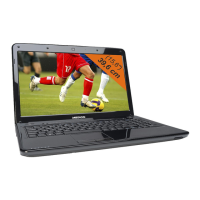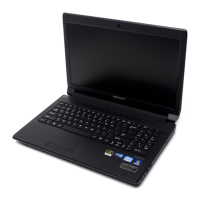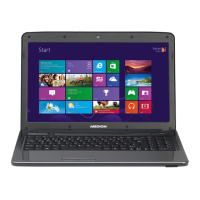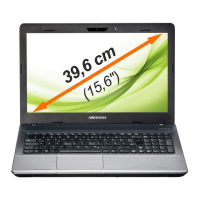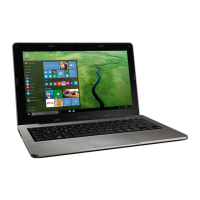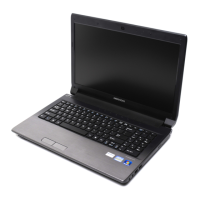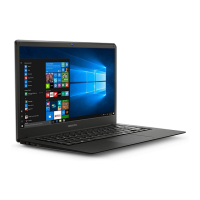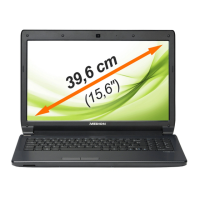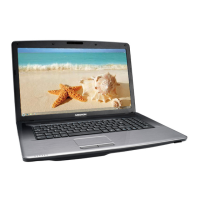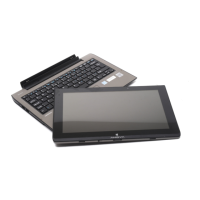Do you have a question about the Medion AKOYA and is the answer not in the manual?
Explains the meaning of warning symbols and keywords used in the manual.
Defines the intended use and limitations of the notebook.
States compliance with R&TTE and Ecodesign Directives.
Warns about risks for children and those with limited abilities.
Provides guidelines for safe and reliable operation of the notebook.
Advises against self-repair due to electric shock risk.
Emphasizes backing up data before updates to prevent loss.
Guides on choosing a safe and suitable location for the notebook.
Specifies operating and storage temperature and humidity ranges.
Advises on optimal screen positioning to protect eyes and avoid glare.
Instructions for connecting the notebook to power and peripherals.
Guidelines for safe cable management and connections.
Explains how to operate the touchpad correctly.
Cautions on battery replacement and care for performance.
Lists the items included with the notebook, such as the battery and adapter.
Illustrates and labels the components of the open notebook.
Identifies ports and connectors on the left side of the notebook.
Identifies ports and connectors on the right side of the notebook.
Guides on initial setup, battery insertion, and powering on.
Explains how to use the notebook's power on/off switch.
Details connecting and using the notebook with mains power.
Provides guidelines for charging and discharging the battery.
Instructions on safely removing the notebook battery.
Explains how the battery charges via the mains adapter.
Advises operating until low battery to optimize lifespan.
Discusses factors affecting battery operating time and configuration.
Shows how to check the current battery charge status.
Covers power-saving functions for optimizing battery life.
Explains the sleep mode function and its automatic restart.
Details the ECO function for saving energy via Fn+F2.
Instructions for changing display modes, including safety.
How to open and close the notebook display.
Provides guidance on using the touch screen.
Advises on proper operation of the touch screen to avoid damage.
Explains common touch screen gestures for navigation and control.
Details the notebook's display resolution and external monitor options.
How to customize desktop background, screensaver, and graphics settings.
Steps to connect and configure an external monitor.
Details modes like Duplicate, Extend, PC Screen Only, Second Screen.
Explains the notebook keyboard layout and function keys.
Lists special Fn key combinations for notebook functions.
Details touchpad operation and settings.
Explains two-finger gestures for enhanced touchpad control.
Explains the purpose of key directories on the hard drive.
Instructions for inserting discs into the optical drive.
How to manually release a disc from a blocked drive.
Information on playing audio CDs and DVDs.
Explains DVD region coding and playback restrictions.
Discusses considerations for blank CDs and DVDs.
Information on optional drive/battery installation.
Safety precautions before exchanging the optical drive.
Steps for replacing the optical drive with a hard drive or battery.
Details connecting external audio devices and volume control.
Defines a network and provides examples of its use.
How to connect to a wired network using an RJ45 cable.
Information on establishing a wireless network connection.
Requirements for using WLAN access points and networks.
Explains Bluetooth technology and its applications.
How to enable/disable flight mode and its effect on wireless connections.
Instructions for inserting memory cards into the reader.
Steps for safely removing memory cards.
Explains the function of the integrated webcam.
Details USB ports and connection guidelines.
How to set up a power-on password for security.
Overview of system software and introduction to Windows 8.
Steps for activating Windows 8 online or via phone.
Covers new features, accounts, taskbar, jump lists, desktop, device management, home group, and start screen.
Access and configure various system settings via Control Panel menus.
How to restart, sleep, or shut down the notebook.
Options for restoring the notebook to factory settings.
How to enter and use the UEFI firmware settings.
Accessing help and support resources for Windows 8.
Common questions and answers regarding setup and troubleshooting.
Initial steps for troubleshooting hardware issues.
Guides on checking connections and power for troubleshooting.
Lists common faults and their solutions.
Information on contacting customer support for further assistance.
Where to find and update drivers for the notebook.
Precautions and guidelines for transporting the notebook.
Tips for cleaning and maintaining the notebook for longevity.
Instructions for cleaning and protecting the notebook display.
Important notes for technicians performing service or upgrades.
Safety information regarding laser radiation from the optical drive.
Information on proper recycling and disposal of the notebook and batteries.
Details the standard for pixel defects on LCD displays.
Explains the structure of pixels and sub-pixels in LCD displays.
Classifies different types of pixel defects (Type 1, 2, 3).
Statement of compliance with FCC rules for digital devices.
Explains the meaning of warning symbols and keywords used in the manual.
Defines the intended use and limitations of the notebook.
States compliance with R&TTE and Ecodesign Directives.
Warns about risks for children and those with limited abilities.
Provides guidelines for safe and reliable operation of the notebook.
Advises against self-repair due to electric shock risk.
Emphasizes backing up data before updates to prevent loss.
Guides on choosing a safe and suitable location for the notebook.
Specifies operating and storage temperature and humidity ranges.
Advises on optimal screen positioning to protect eyes and avoid glare.
Instructions for connecting the notebook to power and peripherals.
Guidelines for safe cable management and connections.
Explains how to operate the touchpad correctly.
Cautions on battery replacement and care for performance.
Lists the items included with the notebook, such as the battery and adapter.
Illustrates and labels the components of the open notebook.
Identifies ports and connectors on the left side of the notebook.
Identifies ports and connectors on the right side of the notebook.
Guides on initial setup, battery insertion, and powering on.
Explains how to use the notebook's power on/off switch.
Details connecting and using the notebook with mains power.
Provides guidelines for charging and discharging the battery.
Instructions on safely removing the notebook battery.
Explains how the battery charges via the mains adapter.
Advises operating until low battery to optimize lifespan.
Discusses factors affecting battery operating time and configuration.
Shows how to check the current battery charge status.
Covers power-saving functions for optimizing battery life.
Explains the sleep mode function and its automatic restart.
Details the ECO function for saving energy via Fn+F2.
Instructions for changing display modes, including safety.
How to open and close the notebook display.
Provides guidance on using the touch screen.
Advises on proper operation of the touch screen to avoid damage.
Explains common touch screen gestures for navigation and control.
Details the notebook's display resolution and external monitor options.
How to customize desktop background, screensaver, and graphics settings.
Steps to connect and configure an external monitor.
Details modes like Duplicate, Extend, PC Screen Only, Second Screen.
Explains the notebook keyboard layout and function keys.
Lists special Fn key combinations for notebook functions.
Details touchpad operation and settings.
Explains two-finger gestures for enhanced touchpad control.
Explains the purpose of key directories on the hard drive.
Instructions for inserting discs into the optical drive.
How to manually release a disc from a blocked drive.
Information on playing audio CDs and DVDs.
Explains DVD region coding and playback restrictions.
Discusses considerations for blank CDs and DVDs.
Information on optional drive/battery installation.
Safety precautions before exchanging the optical drive.
Steps for replacing the optical drive with a hard drive or battery.
Details connecting external audio devices and volume control.
Defines a network and provides examples of its use.
How to connect to a wired network using an RJ45 cable.
Information on establishing a wireless network connection.
Requirements for using WLAN access points and networks.
Explains Bluetooth technology and its applications.
How to enable/disable flight mode and its effect on wireless connections.
Instructions for inserting memory cards into the reader.
Steps for safely removing memory cards.
Explains the function of the integrated webcam.
Details USB ports and connection guidelines.
How to set up a power-on password for security.
Overview of system software and introduction to Windows 8.
Steps for activating Windows 8 online or via phone.
Covers new features, accounts, taskbar, jump lists, desktop, device management, home group, and start screen.
Access and configure various system settings via Control Panel menus.
How to restart, sleep, or shut down the notebook.
Options for restoring the notebook to factory settings.
How to enter and use the UEFI firmware settings.
Accessing help and support resources for Windows 8.
Common questions and answers regarding setup and troubleshooting.
Initial steps for troubleshooting hardware issues.
Guides on checking connections and power for troubleshooting.
Lists common faults and their solutions.
Information on contacting customer support for further assistance.
Where to find and update drivers for the notebook.
Precautions and guidelines for transporting the notebook.
Tips for cleaning and maintaining the notebook for longevity.
Instructions for cleaning and protecting the notebook display.
Important notes for technicians performing service or upgrades.
Safety information regarding laser radiation from the optical drive.
Information on proper recycling and disposal of the notebook and batteries.
Details the standard for pixel defects on LCD displays.
Explains the structure of pixels and sub-pixels in LCD displays.
Classifies different types of pixel defects (Type 1, 2, 3).
Statement of compliance with FCC rules for digital devices.

